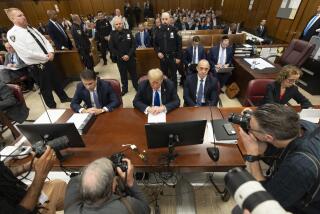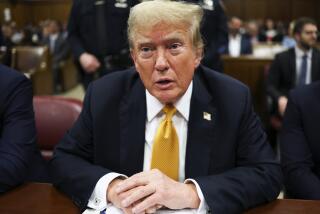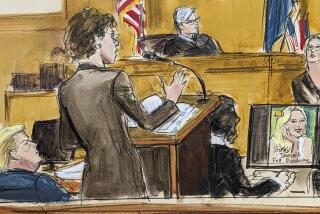Stewart Case Poses Challenges for All Parties as Trial Begins Today
NEW YORK — For sheer spectacle, the Michael Jackson legal drama playing out in Santa Barbara County has a rival: the trial of home-and-hearth tycoon Martha Stewart.
The fraud and obstruction-of-justice case against Stewart and her former Merrill Lynch stockbroker is being avidly dissected in the tabloids and talk shows. It is the topic at cocktail parties in New York and in office cubicles on Wall Street and beyond. It’s keeping the Internet humming, with help from Stewart herself: She has promised visitors to her website a new feature this week called “Trial Update.”
The trial opens today with the questioning of potential jurors. Absent a last-minute settlement, the proceedings are expected to last five to six weeks.
Stewart’s standing as one of the most prominent defendants since O.J. Simpson not only ups the pressure on the government to score a victory in its war on financial crime but also poses broad challenges for all involved.
U.S. District Judge Miriam Goldman Cedarbaum, for example, already is struggling to contain the frenzy of publicity.
First, in early January, she ordered news organizations not to contact potential jurors. Then, in an action more typical of Mafia trials, she ordered the courtroom closed to the media during jury selection. Cedarbaum, 74, who, like Stewart, is a graduate of Manhattan’s elite Barnard College, said the media crush might inhibit jurors from being candid about any preconceptions that could keep them from being open-minded.
Such bias might be especially prevalent with a defendant as well known as Stewart, 62, a onetime model who founded a media empire based on her cooking and decorating flair.
“In 99% of cases, the jury has an impression of the crime but no impression of the defendant,” said lawyer W. Neil Eggleston, a white-collar defense specialist. He said litigators in a case like Stewart’s must decide whether to “embrace the celebrity’s status” or try to neutralize it.
In questioning potential jurors, lawyers probably will try to gauge their financial sophistication and probe their attitudes toward Stewart, the stock market and perhaps business ethics, jury consultant Charles Kauffman speculated.
Armed with pretrial polling results, lawyers can make educated guesses about how age, gender, occupation and income might shape such attitudes, Kauffman said, but it’s hardly a perfect science: “Most of the time you’re stuck with a jury whose qualities remain a mystery.”
Once the trial begins, Stewart’s chief lawyer, Robert G. Morvillo, is expected to hammer the theme he sounded at the time of her indictment in June, when he suggested that his client was targeted because she was a famous and successful woman.
Former Manhattan U.S. Atty. James B. Comey, who has since moved on to the No. 2 spot at the Justice Department, took the celebrity issue head-on in announcing the indictment.
“Martha Stewart,” he said, “is being prosecuted not because of who she is but because of what she did.”
What she mainly did, according to the nine-count indictment, was lie.
The charges stem from Stewart’s December 2001 sale of $228,000 worth of stock in ImClone Systems Inc., a biotech firm then headed by her friend Samuel D. Waksal. The sale came a day ahead of news of an adverse Food and Drug Administration ruling on ImClone’s key cancer drug, Erbitux. Investigators say Stewart dodged losses of $45,673 by bailing out before the news torpedoed the stock.
Waksal pleaded guilty to insider trading for selling some family members’ ImClone stock -- and trying to sell some of his own -- on the same day. He is serving a seven-year prison sentence.
Peter E. Bacanovic, 41, was Waksal’s broker as well as Stewart’s. Prosecutors say Bacanovic had his assistant, Douglas Faneuil, tip off Stewart about the Waksal sales. They say Bacanovic and Stewart lied to investigators, concocting a phony story that they had previously agreed to dump the stock if it fell below $60 a share, which it did on the day of the sale.
Faneuil, 28, who pleaded guilty to the misdemeanor of taking gifts from Bacanovic in exchange for initially lying to investigators, is expected to be the key witness for the prosecution, a team headed by Karen Patton Seymour, chief of the criminal division of the Manhattan U.S. attorney’s office.
The most unusual count in the indictment accuses Stewart of securities fraud. By publicly proclaiming her innocence and describing the arrangement to sell the ImClone stock at $60, prosectors say, Stewart was trying to prop up the shares of her own company, Martha Stewart Living Omnimedia Inc., and misleading investors.
(No Omnimediashareholder, of course, has been hurt more than Stewart, who owns 61% of the company. The scandal has pummeled the firm’s stock, lopping some $250 million off the value of Stewart’s stake, now worth about $350 million.)
Judge Cedarbaum, while rejecting a defense motion to dismiss the fraud charge, called it “a novel application of securities laws.”
Morvillo is expected to attack the fraud charge as an unfair attempt to criminalize Stewart’s natural wish to defend her reputation.
The biggest question for Morvillo is whether to put Stewart on the stand. He has said he wouldn’t decide until after the prosecution had presented its case.
Although juries are curious about a defendant’s views, exposing a defendant to cross-examination is always risky. However, if Faneuil holds up well on the witness stand and the rest of the government’s case appears strong, experts say, Morvillo may have no choice but to let Stewart explain her side.
Laura Ariane Miller, a criminal defense lawyer in Washington, said that whether or not Stewart testifies, Morvillo must stay firmly in charge of legal strategy.
“When the client is so accomplished and skillful in so many areas, it is very hard to tell them that their instincts are wrong,” Miller said.
While preparing for the trial, Stewart has been busy managing her image. Besides sitting for network TV interviews with Barbara Walters and Larry King, she has assisted her public relations firm in updating her MarthaTalks.com website with public statements, photographs and testimonials from supporters.
The site offers an open letter from Stewart, saying she is “hopeful and optimistic that I will be exonerated” and adding: “As part of my promise to keep you informed about key developments in this matter, my attorneys and I will do our best to post transcripts and other relevant items from the trial.”
The judge hasn’t said anything about Stewart’s website. In any case, keeping a lid on the Internet may be impossible.
The judge’s ban on media interviews with prospective jurors didn’t keep one purported member of the jury pool from tattling to the celebrity-oriented website Gawker.com.
This person claimed he was among the hundreds called to the courthouse this month to fill out a 35-page questionnaire meant to weed out candidates who knew people involved in the case or were otherwise biased.
According to his mildly mocking account, one of the questions was, “Have you ever made a project or cooked a recipe from Martha Stewart?”
More to Read
Sign up for Essential California
The most important California stories and recommendations in your inbox every morning.
You may occasionally receive promotional content from the Los Angeles Times.










